Four-terminal (4T) perovskite tandem solar cells (TSCs) show significant efficiency advantages by independently optimizing sub-cells and circumventing current matching limitations. Its modular design supports flexible material selection and preparation processes, becoming an important way to break through the efficiency limit of single-junction devices. This article focuses on the core structure and multiple configurations of four-terminal tandem cells (such as PVK/Si, PVK/CIGS, etc.), and analyzes its performance improvement strategies and challenges through key data provided by the Meineng QE quantum efficiency tester.
The core structural advantages of four-terminal laminated solar cells
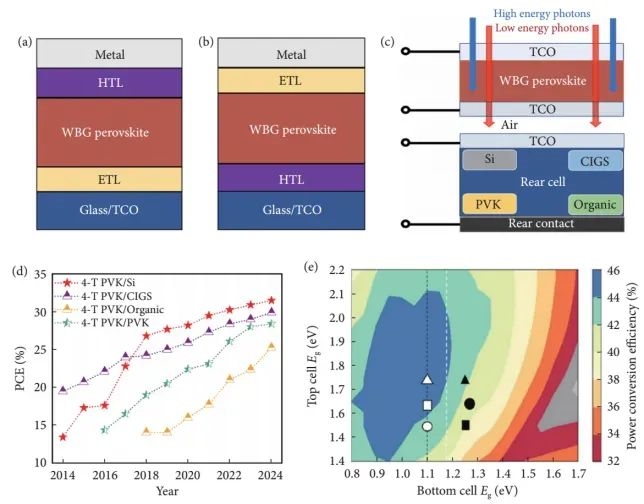
Schematic diagram of perovskite structure and four-terminal stacked cell
(a) n-i-p structure;(b) p-i-n structure;(c) four-terminal stacked cell device architecture;(d) efficiency evolution;(e) theoretical efficiency limit
In the four-terminal structure, the wide bandgap (WBG) perovskite top cell and the narrow bandgap (NBG) bottom cell are electrically isolated by mechanical stacking. The top cell adopts n-i-p or p-i-n structure, and the bottom cell can be silicon, CIGS, organic or perovskite material. The core advantages include:
Independent optimization: sub-cells can select the best materials and processes respectively (such as high-temperature treated n-i-p top cells and low-temperature bottom cells are compatible).
Current mismatch: no current matching is required, expanding the range of wide-gap combination selection (such as PVK/Si theoretical efficiency upper limit of 46%).
High stability: sub-cells operate independently, local damage does not affect the overall function, and reduces the risk of system failure.
Optical management: The top cell needs to have high light transmittance (e.g. DMSA treatment reduces the surface roughness to 10.5 nm, and the near-infrared transmittance reaches 83.94%) to ensure that the bottom cell effectively absorbs light.
PVK/Si stacked cell
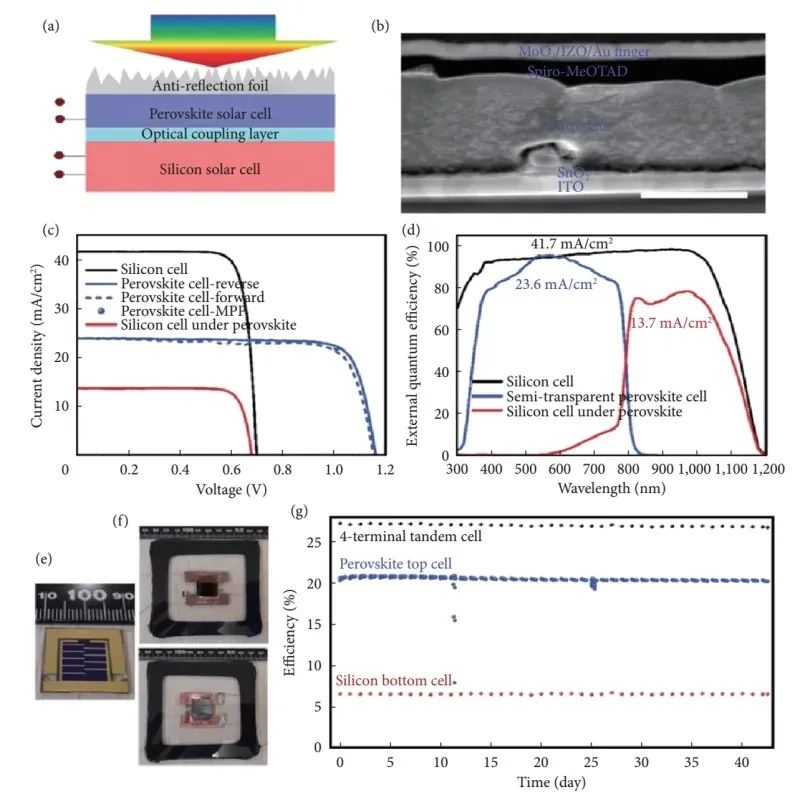
Performance and stability of four-terminal perovskite/silicon tandem cells
(a) Structural diagram; (b) Cross-sectional SEM image; (c) Subcell J-V curve; (d) Top cell and bottom cell EQE spectra; (e) 1 cm² top cell real image; (f) Top and bottom views of packaged device; (g) Efficiency stability
PVK/Si stacking combines the high stability of silicon (market share exceeds 90%) with the efficient spectral utilization of perovskites.
Efficiency breakthrough: Combined with silicon heterojunction (SHJ), TOPCon and other technologies, the efficiency of four-terminal PVK/Si exceeds 30%. For example:
Interface engineering: Studies have shown that by treating the ITO surface with hydrofluoric acid/ultraviolet ozone and optimizing the adsorption of self-assembled monolayers (SAM), the top cell efficiency reached 22.9% and the stacking efficiency reached 30.3%.
Stability improvement: The introduction of rubidium-doped CsFAMA perovskite, the unpackaged device maintained 98% of the initial efficiency after 42 days of day and night cycles.
Optical optimization: Use high-transmittance infrared electrodes such as AZO and IZRO (such as IZRO's transmittance is 10% higher than ITO), and introduce inverted pyramid textured glass to reduce reflection losses.
PVK/CIGS stacking cells
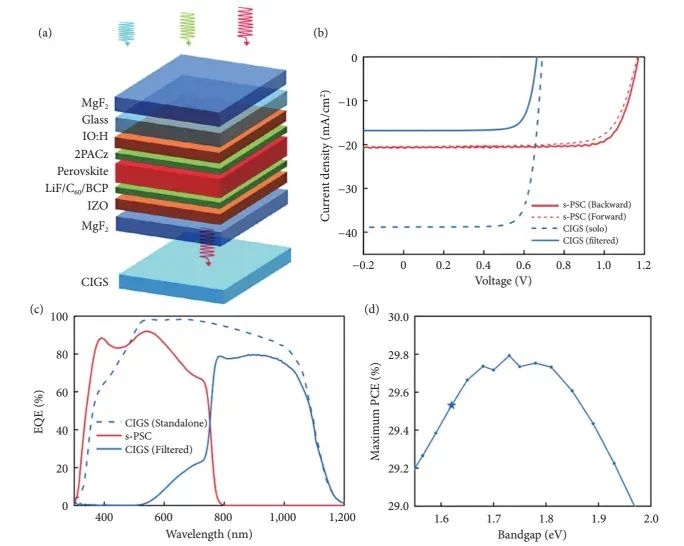
Four-terminal perovskite/CIGS tandem cell performance
(a) Layered structure; (b) Semi-transparent perovskite top cell J-V curve; (c) Top cell and filtered CIGS bottom cell EQE spectra; (d) Simulation prediction of perovskite bandgap on tandem efficiency.
CIGS (bandgap ~1.0 eV) as the bottom cell, forms an ideal spectral complement to the wide-bandgap perovskite.
Efficiency record: The efficiency reached 23.9% by combining the four-cation perovskite (CsRbFAMA) with the CIGS bottom cell. Key advances include:
Electrode innovation: Developing multilayer electrodes (dielectric/metal/dielectric) to improve light transmittance and conductivity.
Material compatibility: Removing the MoOₓ buffer layer to avoid sputtering damage, the top cell efficiency is 19.5%, and the tandem efficiency is 26.2%.
Challenges: The infrared response of the CIGS bottom cell is limited by the parasitic absorption of the TCO (such as AZO absorption rate>3%), and the electrode design needs to be optimized.
PVK/organic tandem cell
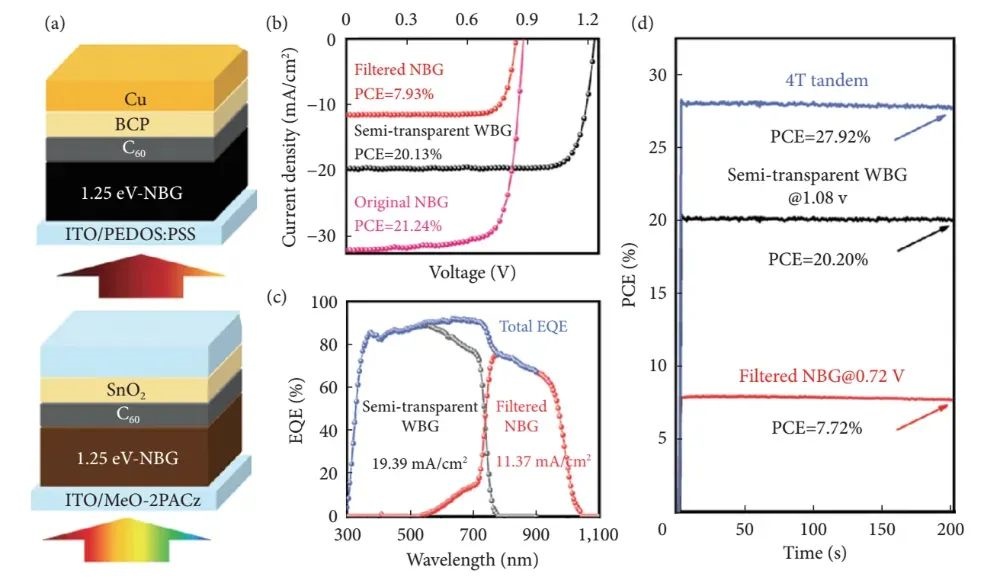
Performance of CsPbI₂.₂₅Br₀.₇₅ thin films prepared by drop coating
(a) SEM image of uniform surface; (b) J-V curves of drop coating and spin coating devices; (c) Transmittance of semi-transparent cells; (d) J-V curve of organic bottom cells after filtering; (f) Effect of light filtering on the life of organic cells
The lightweight and flexible properties of organic solar cells (OSCs) combined with perovskites are suitable for automotive and wearable devices.
Efficiency potential: The efficiency reaches 22.34% by combining the CsPbI₂.₂Br₀.₂₅ top cell with the PM6:Y6 organic bottom cell. Highlights include:
UV protection: The perovskite top cell acts as a UV filter to extend the life of the organic cell (efficiency remains at 86% after 120 hours of illumination).
Process innovation: The drop coating method improves the uniformity of the perovskite film and reduces the defect density.
Limitations: Organic materials have poor stability and need to develop oxidation-resistant and highly transparent electrodes (such as silver nanowires/PEDOT: PSS).
All-perovskite (PVK/PVK) stacked cells
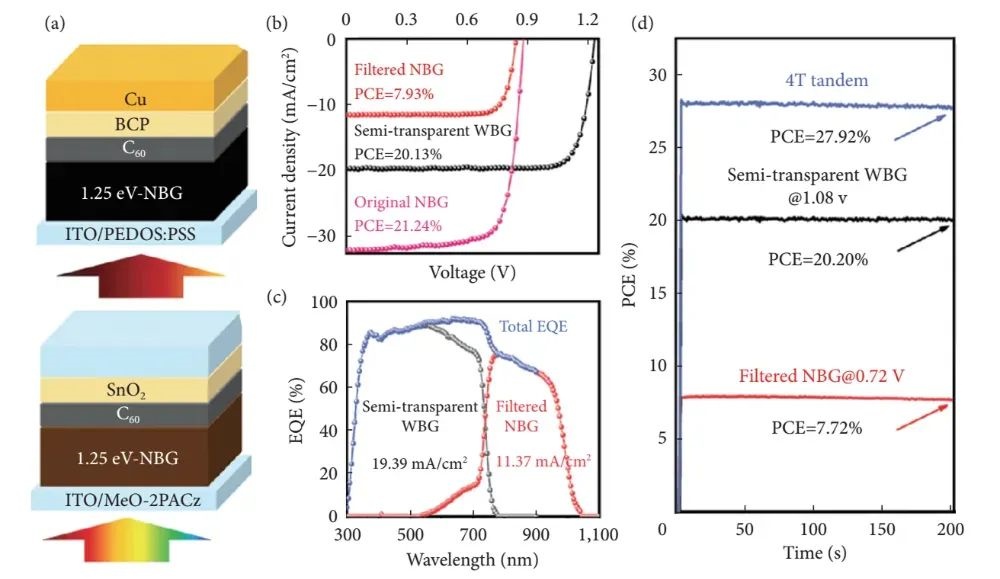
Performance of all-perovskite four-terminal tandem cell
(a) Cell structure; (b) J-V curves of semi-transparent top cell and filtered bottom cell; (c) EQE spectra of each sub-cell; (d) Steady-state power output
The all-perovskite tandem achieves bandgap matching by adjusting the components (top 1.67–1.75 eV, bottom 0.80–1.20 eV), supporting low-temperature solution processing and roll-to-roll manufacturing.
Efficiency breakthrough: By adjusting the crystal orientation of WBG perovskite by DBSA additive, the top cell efficiency is 22.4% and the tandem efficiency is 28.06%. Key strategies include:
Bandgap regulation: The bandgap of Sn-Pb alloy perovskite bottom cell is 1.25 eV, which complements the 1.66 eV top cell.
Defect passivation: Acetylcholine chloride (ACh) modifies the PEDOT:PSS interface to reduce non-radiative recombination.
Challenges: Sn²⁺ is easily oxidized and requires inert atmosphere encapsulation; narrow bandgap perovskites have short carrier lifetimes (<20 ns).Summary of the performance of all-perovskite four-terminal tandem cell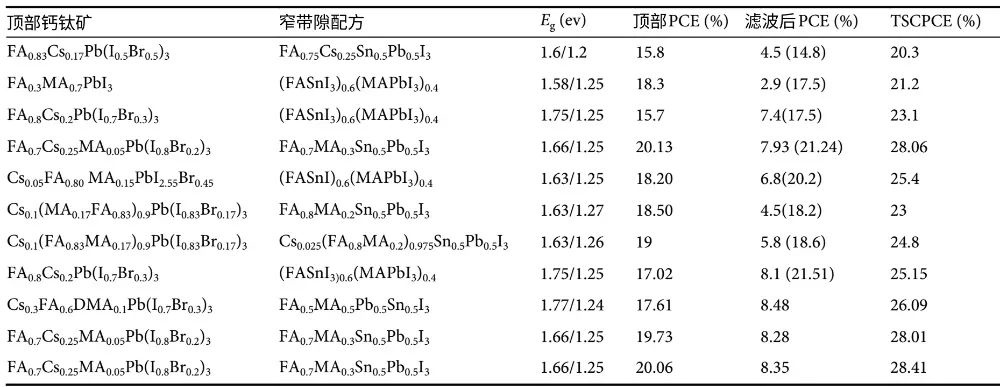
Four-terminal perovskite tandem solar cells have shown significant advantages in efficiency and flexibility through structural innovation and material synergy. Achieving an efficiency breakthrough of over 30% in configurations such as PVK/Si and PVK/CIGS, all-perovskite tandems have great potential in low-cost manufacturing, and emerging structures provide a new dimension for the use of infrared spectra.